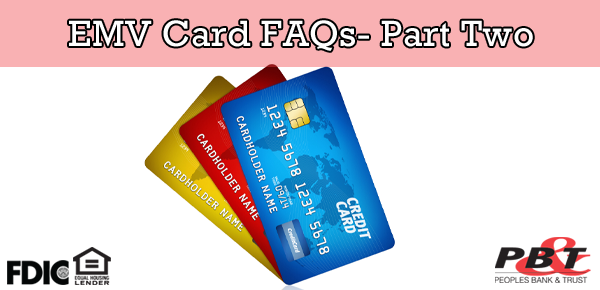
Today we’re hitting the second part of our EMV Card FAQ session. We started our FAQ discussion in our last blog post, so be sure to go back and check out that post. Let’s hop right in with more common questions about EMV cards.
Will I still have to sign or enter a PIN for my card transaction?
Yes, but the default method depends on which verification is tied to your card. Chip-and-PIN cards work just like debit cards, whereas chip-and-sign cards require a signature for authentication.
What happens if fraud does occur? Who is liable?
The party which is least EMV-compliant. For example, if you are issued an EMV card from PB&T and use it at a retailer that hasn’t upgraded its payment system for the new cards, after which your data is stolen, the retailer would be liable.
What if the retailer I’m at doesn’t have a chip-card reader? Will my EMV card still work?
Yes. The first round of EMV cards being issued will have both the chip and a magnetic strip. The only thing you lose out on is the additional security of the chip. However, as we mentioned before, the retailer would be liable for any fraud that happens in this instance.
Will my EMV card work outside the country?
Yes and no. The United States is one of the last major countries to adopt EMV technology. If you’re traveling abroad you may find you won’t be able to use your card to swipe. As long as your credit card has a chip in it, you will run into fewer issues.
If you have any other questions relating to EMV cards and when the change is happening for Peoples Bank & Trust customers, please contact the Debit Card Department at (636) 528-7001.
Peoples Bank & Trust Co.
Equal Housing Lender
Member FDIC

